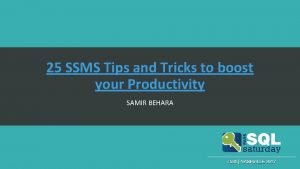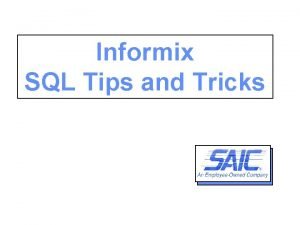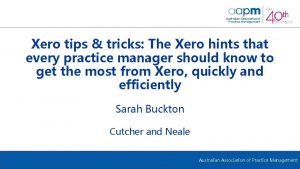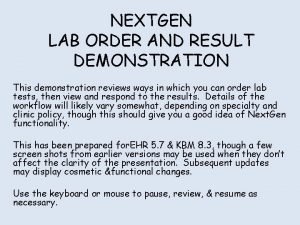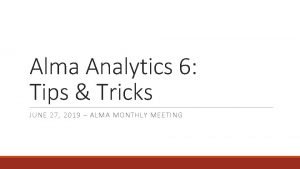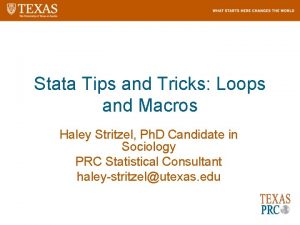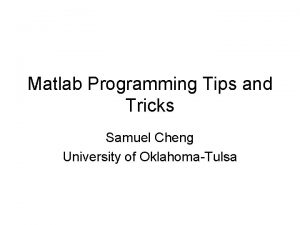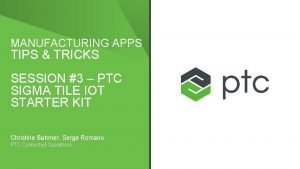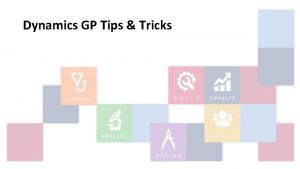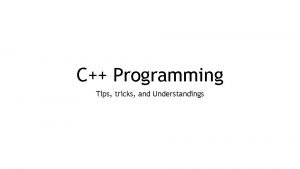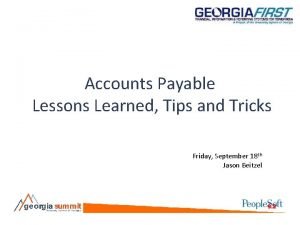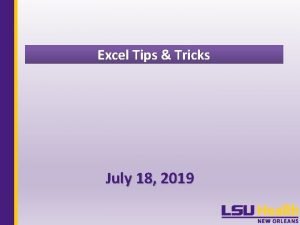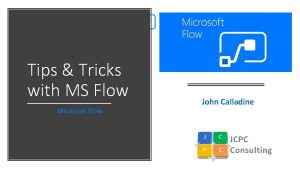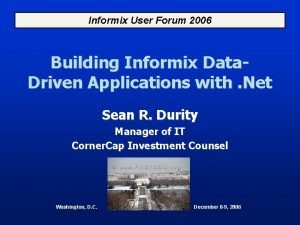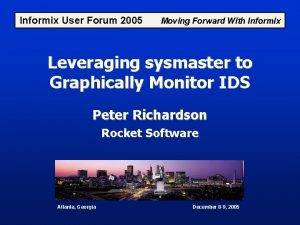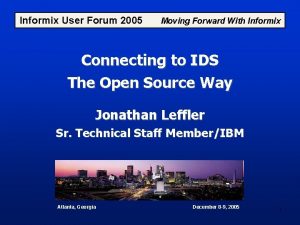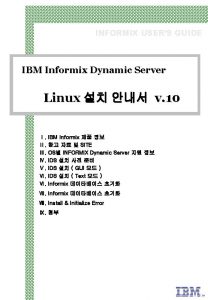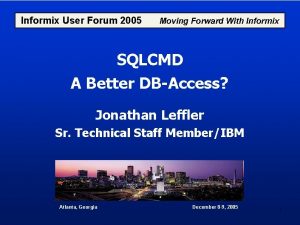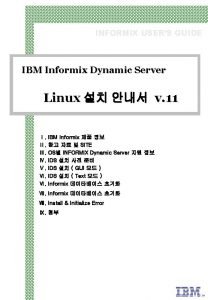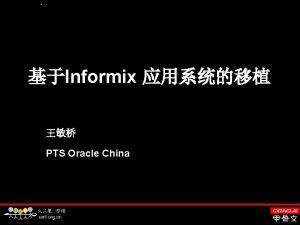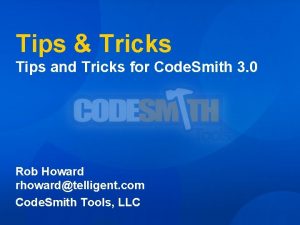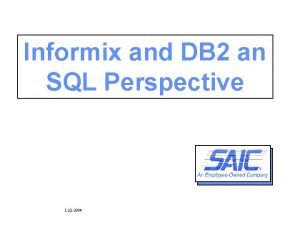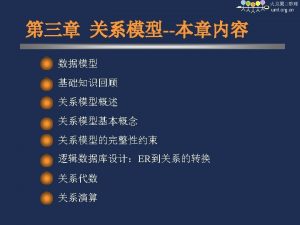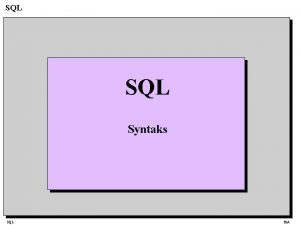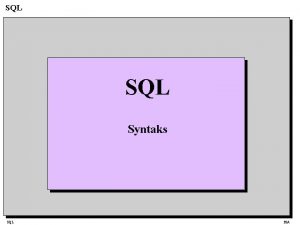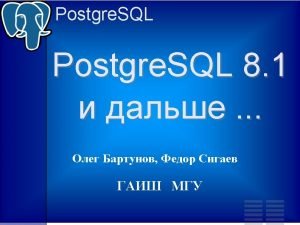Informix SQL Tips and Tricks SQL Tips and































- Slides: 31

Informix SQL Tips and Tricks

SQL Tips and Tricks Bob Carts Senior Data Engineer, SAIC robert. carts@saic. com Warren Donovan Senior DBA, SAIC warren. donovan@saic. com 3/6/2002 Slide 2

Introduction l Certified Informix DBAs l WAIUG Board of Directors l Work for SAIC l NT and UNIX (Solaris, IBM AIX) l IDS 7. 31, 9. 21, 9. 3 and XPS 8. 3 l Data Warehouse and OLTP Applications Informix 3/6/2002 Slide 3

Introduction l Some Tips/Syntax work on specific releases l Be careful with your data! l Many other techniques in shell script and stored procedures not included here l What release are you using? 3/6/2002 Slide 4

Introduction l Data Warehouse Project l ETL Programming l Evolution ØC programs Ø Stored Procedures Ø SQL l Good Introduction to SQL 3/6/2002 Slide 5

New Commands (or sort of new) l Case - Useful in transforming data (7. 3 on) l decode - (7. 3 on) l NVL function - l first - Just get a few rows (7. 3 on) l middle - Just get some middle rows (XPS only) 3/6/2002 Slide 6

Case Statement l l l Generic or Linear Can be nested and contain subqueries, functions Can be contained within functions Result must be a common datatype Finds first true statement and then stops select hospital, case when beds < 100 then “small” when beds > 99 then “big” else “No Value” l Linear Format case beds when < 100 then “small” when > 99 then “big” else “No Value” 3/6/2002 Slide 7

Case Statement l Example: case when MOD("11 -30 -2001"-(enterdate), 30))/30)+1 > 1 then ((servicesraw)/(0. 993712 -(1. 046021*EXP(-0. 362649* POW((("11 -30 -2001"- (enterdate)-MOD("11 -30 -2001"(enterdate), 30))/30)+1, 0. 925358))))) else null end l Example: sum(case when donotcount_flag ="0" then 0 when donotcount_flag is null then 0 else entry_count end 3/6/2002 Slide 8

Other Statements l Decode Ø can’t decode a null select manufacturer, DECODE(beertype, 1, “stout” 2, “ale” 3, “lager”, “other”) … l NVL function Select applicant, NVL(age, “age not available”)… Ø Example 1 - If middle name is null then entire result is null select trim(last_name)||", "||trim(first_name)||" "|(middle_name[1], "") from staff; Ø Example 2 - Fixed with NVL select trim(last_name)||", "||trim(first_name)||" "||nvl(middle_name[1], "") from staff; 3/6/2002 Slide 9

Other Statements l First (7. 3, 8. 3, 9. 2, 9. 3) l Select first 10 * from bigtable; Ø Can’t say into temp/scratch table Ø Can’t use in subquery or select clause of insert statement Ø Can’t uses as embedded select statement expression Ø Can use order by (first 10 after sort) l Middle (XPS only) Ø returns middle rows! 3/6/2002 Slide 10

Cleaning up Data l Delete from l Rename table l Truncate Ø The TRUNCATE TABLE <tablename> command quickly drops all data in a table and resets the extents. A quick way to clear out a table, is equivalent to dropping and rebuilding a table: it not only instantly drops all the data, but actually resets all of the tables extents at the same time! Ø WARNING: this command cannot be rolled back! Available in 8. 3 x Alter table drop Column/add Column 3/6/2002 Slide 11

Cleaning up Data l Cleaning up a column Ø Example: update tablename set status = “”; Ø Another Example Alter tablename drop status; Alter tablename add status; 3/6/2002 Slide 12

Testing and Test Data l Test your SQL without mangling your database l Issue a “begin work; ” statement, then run your code, then issue a “rollback; ” statement Ø Only works with logged databases!! Ø Only works for code that doesn’t have commits !! Ø Always make sure you have a backup of your data!! l Add a where condition that can’t be true: where 1= 2; l Set Explain On Avoid Execute; 3/6/2002 Slide 13

Testing and Test Data l Table is huge, just want a few rows for test data Ø Create testtable Ø Unload to “filename” Select first 100 * from bigtable; Ø Load from filename insert into testtable; l No test data is available Ø Alter statement to add the new columns and populate using the default clause Ø Then write another alter to remove the default. It leaves the test data behind 3/6/2002 Slide 14

Using Directives l Directives are available in IDS 9. X and XPS 8. 32 and up l Directives force the database engine to run the query the way you tell it to: your directives will only be as good as your knowledge of the data l Force the engine to query tables in the order you specify l Force the engine to use a certain index l Force the engine to ignore indexes l Force the engine to Join tables in a specific way l Optimize for all data l Optimize a quick response 3/6/2002 Slide 15

Using Directives: ORDERED l Forces the engine to query tables in the order you specify in the FROM clause of your SQL statement l Example: SELECT --+ORDERED c. x, c. y, b. z FROM a, b, c WHERE c. x=b. n AND b. z=a. z; Will force the query to scan table a first, table b second and table c third, which would be especially beneficial if tables a and b were both small reference tables 3/6/2002 Slide 16

Using Directives: INDEX / AVOID_INDEX l Forces the engine to use / ignore a specific index l Example: SELECT {+ORDERED, INDEX(a y), AVOID_INDEX(b n)} c. x, c. y, b. z FROM a, b, c WHERE c. x=b. n AND b. z=a. z; Will force the query to scan in the order in the from clause, and to use the index on the a. y column, and to ignore indexes on the b. n column. 3/6/2002 Slide 17

Using Directives: FULL / AVOID_FULL l Forces the engine to perform or to avoid performing a full table scan, even if an index exists. l Example: SELECT {+ORDERED, INDEX(a y), AVOID_INDEX(b n), FULL(c)} c. x, c. y, b. z FROM a, b, c WHERE c. x=b. n AND b. z=a. z; Will force the query to scan in the order in the from clause, to use the index on the a. y column, to ignore indexes on the b. n column and to perform only full table scans on table c. 3/6/2002 Slide 18

Using Directives: JOIN METHOD DIRECTIVES l Forces the engine to perform or to avoid performing certain join methods, such as Nested Loop or Hash Joins. l Example: SELECT {+ORDERED, INDEX(a y), AVOID_INDEX(b n), FULL(c), USE_HASH(c/BUILD)} c. x, c. y, b. z FROM a, b, c WHERE c. x=b. n AND b. z=a. z; Will force the query to scan in the order in the from clause, to use the index on the a. y column, to ignore indexes on the b. n column and to perform only full table scans on table c. Furthermore, on the first join, table c will be used as the table from which the hash index is built for the join with table b, which will be probed. 3/6/2002 Slide 19

Using Directives: OPTIMIZATION GOAL DIRECTIVES l Forces the engine to query the tables in such a way as to produce either the full result set as fast as possible (default) or to get the first rows as quickly as possible. l Example: SELECT {+ORDERED, FIRST_ROWS} c. x, c. y, b. z FROM a, b, c WHERE c. x=b. n AND b. z=a. z; Will force the query to scan in the order in the from clause and to perform the rest of the operations in such a way as to get the first rows of the result set out as quickly as possible. The method may differ significantly from the method optimized to get ALL_ROWS as quickly as possible. 3/6/2002 Slide 20

External Tables l External Tables (XPS only) Ø External Tables replace the HPL on 8. 3 x systems. Essentially, allows you to create a table that you can query with SQL, but is not located in a dbspace: instead, the table points to a flatfile Ø Advantages: extremely fast data load / unload, you can perform SQL against the data flatfiles when loading. Ø Disadvantages: if you insert data into the external table, it immediately overwrites all the data in the table (ie: your flatfiles), cannot update the data, cannot update statistics, so if your SQL query joins it to another table, be sure to use DIRECTIVES. 3/6/2002 Slide 21

External Tables l External Tables (XPS only) basic syntax: CREATE EXTERNAL TABLE <tablename> <define table> *OR* SAMEAS <target tablename> USING ( DATAFILES(location of files), FORMAT <delimited or fixed>, DELIMITER “!”, REJECTFILE “<location of rejectfile>”, EXPRESS or DELUXE (mode) 3/6/2002 Slide 22

External Tables l External Tables (XPS only) basic syntax example: create external table cap_rateext sameas cap_rate using ( datafiles( "disk: 1: /bigfs/cap_rate. unl" ), delimiter '|', rejectfile "/informix/current_version/dump/cap_rate. %c", maxerrors 10, express ); 3/6/2002 Slide 23

Using Temp Tables l Need to create table structures dynamically for temporary use Select * from permanent_table where 1=0 into temp tmptab with no log l Then load the tables with the data you need to evaluate load from “filename” insert into tmptab; 3/6/2002 Slide 24

Using Temp Tables l Example: You have a multi-join query that is taking forever to run l Reduce the number of initial joins and put the results in a temp table, then use the temp table to join to the remaining tables l Worked well in XPS using dynamic indexes 3/6/2002 Slide 25

Generating SQL using SQL l Example: 500 table database needs to have a new datetime column added to every table! l Use a query against the systables table to generate the sql syntax to perform the alter statement. l Careful with long, 128 character names and ping l Simple example shown, you can do most anything limited only by your understanding of the system tables Ø generate wra similar stored procedures and triggers 3/6/2002 Slide 26

Generating SQL using SQL l l The Generating Query: output to addcolumn. sql without headings select "alter table "||tabname, "add chg_dte date; " from systables where tabid > 99 and tabtype = "T"; The result (addcolumn. sql) alter table code_typ_dm add chg_dte date; . alter table lookup_dm add chg_dte date; (and so on …) 3/6/2002 Slide 27

Group by l Task to create a table with id, subid, zip 5 and name from a wider table to lookup names Multiple names exist, need to get only one l id subid zip 5 type name 010211494 0001 04240 46 CENTRAL MAINE 010211494 0001 04240 10 CENTRAL MAINE 010211494 0001 04240 70 CENTRAL MAINE l First Try select id, subid, zip 5, name from storenames group by 1, 2, 3 # ^ # 294: The column (name) must be in the SERVICE MOTORS CTR PARTS GROUP BY list. 3/6/2002 Slide 28

Group by l Second Try-Wrong Name! select id, subid, zip 5, (min)name from storenames group by 1, 2, 3 id subid zip 5 010211494 0001 04240 (min) CENTRAL MAINE PARTS l New info, best single name associated with select id, subid, zip 5, min(type||name) from storenames group by 1, 2, 3 lowest type id subid zip 5 (min) 010211494 0001 04240 10 CENTRAL MAINE SALES CTR l Can strip off the “ 10” later using [3, 43] 3/6/2002 Slide 29

Summary l case l decode l nvl l first l middle l directives l external tables l temp tables l making sql using sql l concatenating group by 3/6/2002 Slide 30

Suggestions l Submit your tips (robert. m. carts@saic. com, warren. donovan@saic. com ) l Will be placed on WAIUG site l Indexed by “How do I”? l Thank You !!! 3/6/2002 Slide 31
 Ssms tips and tricks
Ssms tips and tricks Informix sql commands
Informix sql commands Xero tips and tricks
Xero tips and tricks Alteryx tips
Alteryx tips Next gen labs
Next gen labs Kronos manager login
Kronos manager login Igcse english language paper 1 tips
Igcse english language paper 1 tips Purpose of homework
Purpose of homework Navision tips and tricks
Navision tips and tricks Zhuang wang
Zhuang wang Alma analytics tips and tricks
Alma analytics tips and tricks Magento 2 tips and tricks
Magento 2 tips and tricks Stata tips and tricks
Stata tips and tricks Data analysis tips and tricks
Data analysis tips and tricks Matlab tips and tricks
Matlab tips and tricks Ptc manufacturing apps
Ptc manufacturing apps Accessibility tips and tricks
Accessibility tips and tricks Google
Google Qlik sense tips
Qlik sense tips Gp tips and tricks
Gp tips and tricks Vacuum forming companies near me
Vacuum forming companies near me C programming tricks
C programming tricks Accounts payable tips and tricks
Accounts payable tips and tricks Wpf tips and tricks
Wpf tips and tricks Uil number sense scoring
Uil number sense scoring Branding tips and tricks
Branding tips and tricks Advanced excel tips and tricks 2019
Advanced excel tips and tricks 2019 Kronos tips and tricks
Kronos tips and tricks Windows 7 tricks
Windows 7 tricks Vmware tips and tricks
Vmware tips and tricks Pseudolabeling
Pseudolabeling Microsoft flow tips and tricks
Microsoft flow tips and tricks
